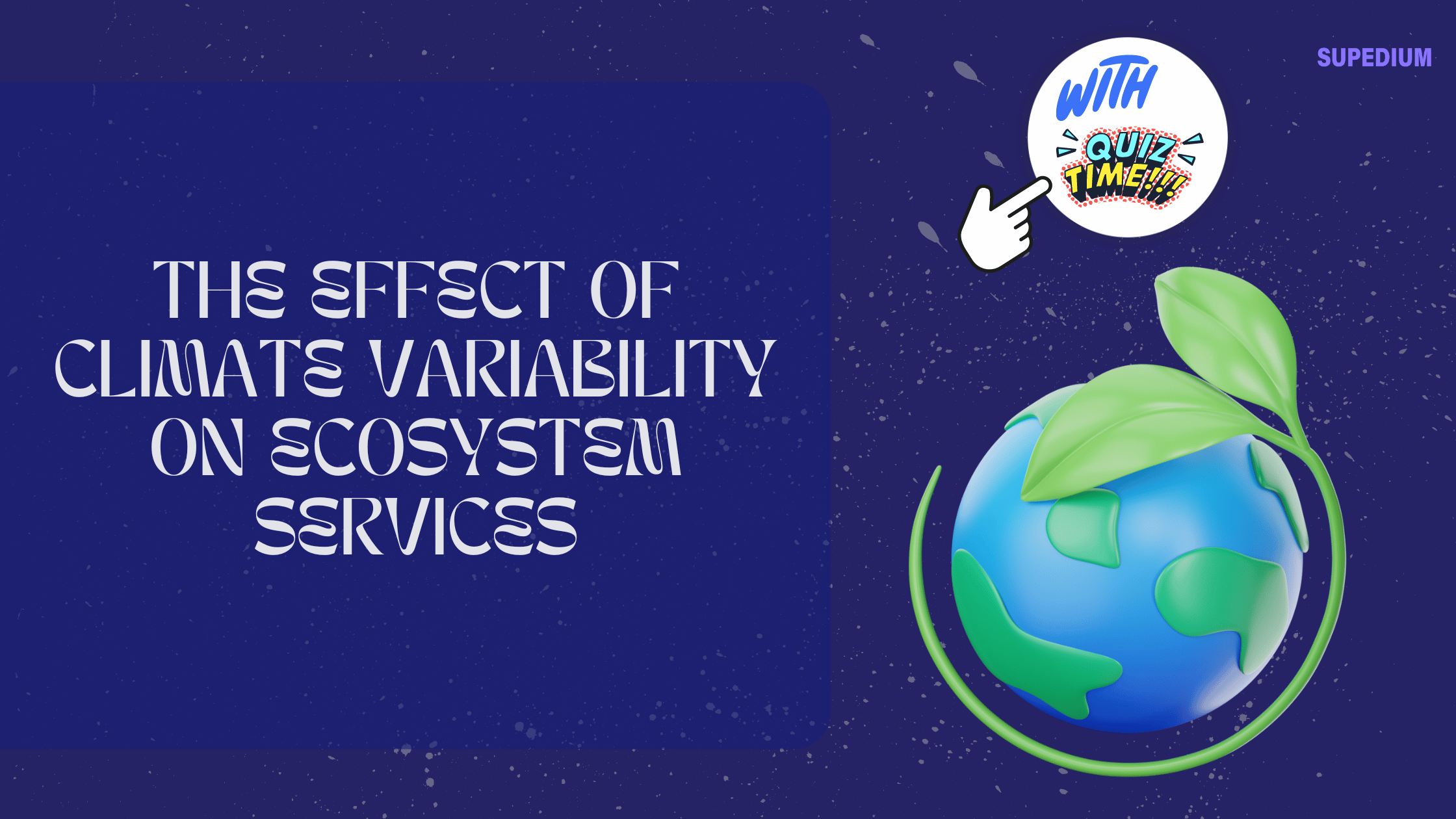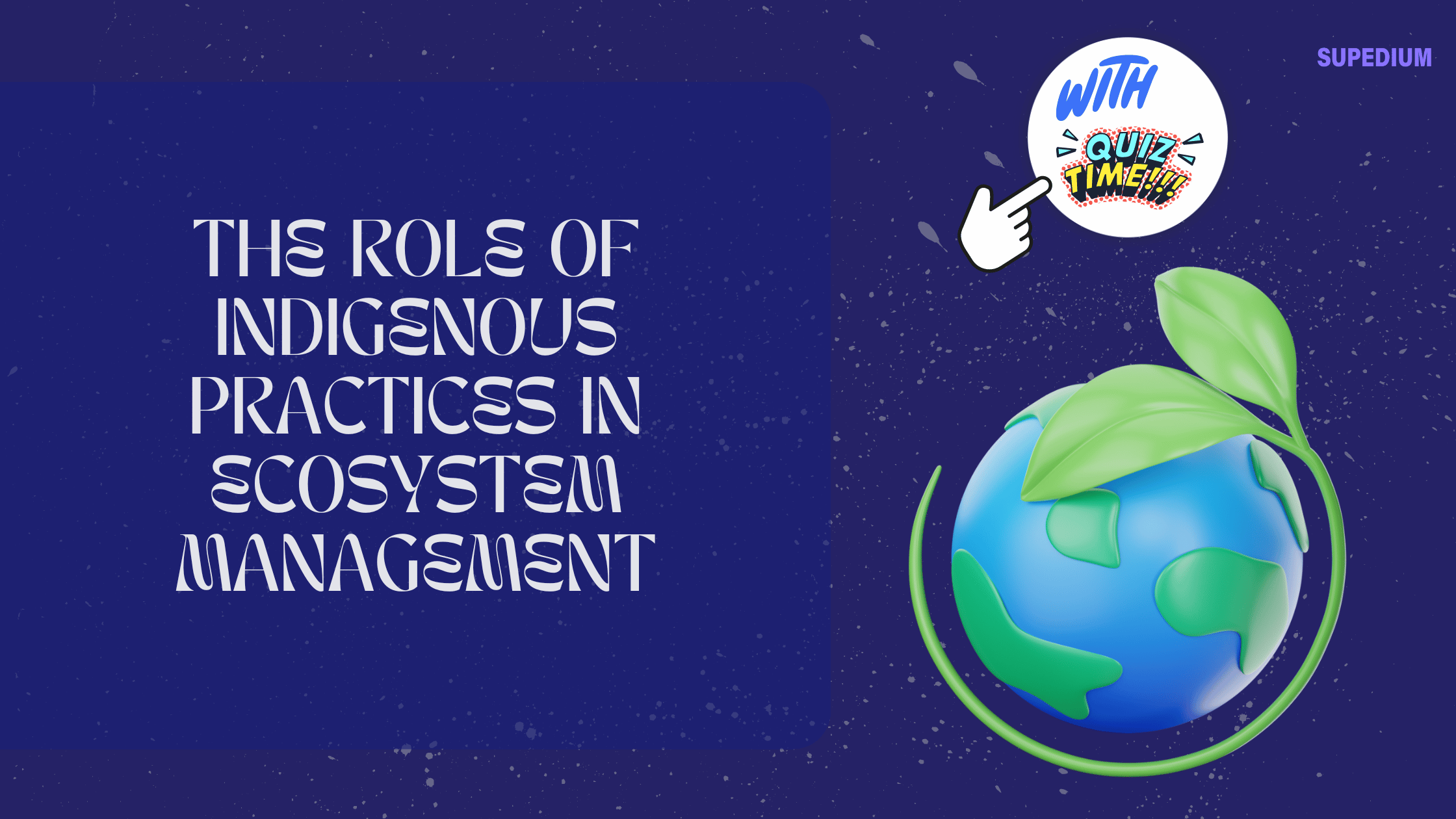Table of Contents
![]()
I. Introduction
Definition of Climate Variability
Climate variability refers to variations in climate patterns over time, which can be on a range of scales from days to decades. Unlike climate change, which denotes long-term shifts in climate due to factors like greenhouse gas emissions, climate variability encompasses short-term fluctuations, such as those driven by phenomena like El Niño and La Niña. These variations can influence weather patterns and environmental conditions significantly, affecting ecosystems and human activities alike.
Definition of Ecosystem Services
Ecosystem services are the benefits that humans derive from natural ecosystems. They are typically categorized into four main types:
- Provisioning Services: These include the supply of resources such as food, water, and raw materials.
- Regulating Services: These services regulate natural processes, such as climate regulation, flood control, and pollination.
- Supporting Services: These are necessary for the production of all other ecosystem services, including nutrient cycling and habitat provision.
- Cultural Services: These involve non-material benefits such as recreational, aesthetic, and spiritual values.
Understanding the impacts of climate variability on these services is crucial for effective environmental management and policy-making.
II. Impact of Climate Variability on Ecosystem Services
A. Provisioning Services
- Food Supply
Climate variability significantly affects agricultural productivity and food supply. Variations in temperature and precipitation can lead to altered growing seasons, reduced crop yields, and increased susceptibility to pests and diseases. For instance, unexpected heatwaves can stress crops, while altered rainfall patterns may affect irrigation needs. Similarly, in marine environments, changes in ocean temperature and currents impact fish stocks and aquaculture, potentially leading to shifts in fish populations and reduced fishery yields.
- Water Resources
Water availability and quality are closely tied to climate variability. Variability in precipitation can result in periods of drought or excessive rainfall, affecting water supply for drinking, irrigation, and industrial use. Additionally, changes in snowmelt patterns can impact river flows and groundwater recharge. Extreme weather events, such as intense storms or prolonged droughts, can also degrade water quality by increasing sedimentation and runoff.
- Raw Materials
Climate variability can influence the availability of raw materials derived from ecosystems. For example, fluctuations in temperature and precipitation affect forest productivity, impacting the supply of timber and non-timber forest products. Changes in growth rates and health of trees can alter the quality and quantity of these materials. Similarly, variability in climate conditions can affect the extraction and availability of minerals and biomass resources.
B. Regulating Services
- Climate Regulation
Ecosystems play a critical role in regulating the climate by sequestering carbon and influencing greenhouse gas levels. Variability in climate can affect these natural carbon sinks. For example, increased temperatures and altered precipitation patterns can impact forest growth and carbon storage, potentially leading to increased carbon emissions. Changes in the behavior of oceans, such as altered currents and sea surface temperatures, also influence global climate patterns.
- Pollination
Pollinators, such as bees, butterflies, and birds, are vital for the reproduction of many plants, including crops. Climate variability affects pollinator populations and their activities. Changes in temperature and flowering patterns can disrupt the synchronization between pollinators and plants, leading to reduced crop yields and decreased biodiversity. For instance, earlier springs may cause flowers to bloom before pollinators are active, affecting both wild and agricultural plant species.
- Flood and Erosion Control
Ecosystems such as wetlands, mangroves, and forests provide natural flood and erosion control. Climate variability, including more intense rainfall and storms, can alter the ability of these ecosystems to perform these functions. Increased frequency and severity of flooding can lead to greater erosion and habitat loss, impacting both human communities and natural habitats. Coastal areas are particularly vulnerable to erosion and storm surges, which can be exacerbated by rising sea levels and more frequent extreme weather events.
C. Supporting Services
- Nutrient Cycling
Nutrient cycling involves the movement and transformation of nutrients through ecosystems. Climate variability can impact these cycles by altering temperature and moisture levels, which affect microbial activity and soil processes. For example, higher temperatures can increase the rate of organic matter decomposition, potentially leading to changes in soil fertility. Variability in precipitation can also affect nutrient leaching and runoff, impacting soil health and plant productivity.
- Habitat Provision
Ecosystems provide critical habitats for a wide range of species. Climate variability can lead to shifts in habitat conditions and species distributions. Changes in temperature and precipitation can affect the suitability of habitats for various species, leading to shifts in community composition and potential loss of biodiversity. For instance, rising temperatures may cause some species to migrate to cooler areas, while others may face habitat loss or extinction.
- Primary Production
Primary production refers to the creation of organic material by plants through photosynthesis. Climate variability can influence plant growth and productivity by altering temperature, precipitation, and atmospheric CO2 levels. Variations in these factors can lead to changes in the timing and amount of primary production, affecting food webs and ecosystem functioning. For example, altered growing seasons and changing plant productivity can impact herbivores and higher trophic levels.
D. Cultural Services
- Recreational and Aesthetic Value
Natural landscapes provide recreational and aesthetic value, contributing to human well-being. Climate variability can affect the attractiveness and accessibility of these landscapes. For instance, changes in weather patterns may impact the quality of outdoor recreational opportunities, such as hiking and skiing. Additionally, extreme weather events and altered vegetation patterns can affect the visual appeal of natural areas, influencing tourism and local economies.
- Cultural Heritage and Spiritual Value
Many cultures have deep connections with their natural surroundings, which influence traditional practices and spiritual beliefs. Climate variability can disrupt these connections by altering landscapes, affecting traditional land use, and influencing cultural practices. For example, changes in the availability of traditional resources or alterations in sacred sites can impact cultural heritage and community identity.
III. Regional and Sectoral Case Studies
A. Tropical Rainforests
Tropical rainforests are highly sensitive to climate variability. Changes in temperature and precipitation can lead to shifts in species composition and forest structure. Variability in climate can also impact the carbon storage capacity of these forests, affecting global carbon cycles. Additionally, increased temperatures and altered rainfall patterns can influence the frequency and intensity of forest fires, further impacting biodiversity and ecosystem services.
B. Arid and Semi-Arid Regions
In arid and semi-arid regions, climate variability can have profound effects on water resources and vegetation. Variability in precipitation can lead to prolonged droughts or sudden floods, impacting water availability and soil health. Changes in vegetation patterns can affect land productivity and biodiversity, influencing both human livelihoods and ecosystem functions.
C. Coastal Ecosystems
Coastal ecosystems, including mangroves, coral reefs, and salt marshes, are particularly vulnerable to climate variability. Variability in sea surface temperatures, storm intensity, and sea level can impact the health and functionality of these ecosystems. For example, coral reefs may experience bleaching events due to elevated sea temperatures, while mangroves and salt marshes may face increased erosion and habitat loss.
IV. Adaptation and Mitigation Strategies
A. Adaptive Management Practices
Adaptive management practices involve adjusting strategies and actions based on ongoing monitoring and learning. Enhancing ecosystem resilience through adaptive management can help mitigate the impacts of climate variability. Examples include implementing sustainable agricultural practices, promoting forest conservation, and restoring degraded wetlands. By incorporating flexibility and responsiveness into management approaches, ecosystems can better withstand and adapt to changing conditions.
B. Policy and Governance
Integrating climate variability into ecosystem management policies is crucial for effective adaptation. Policies should account for potential changes in ecosystem services and incorporate strategies for resilience and risk management. Case studies of successful policy adaptations include the implementation of water conservation measures during droughts and the development of guidelines for managing fisheries under changing climate conditions.
C. Role of Research and Monitoring
Ongoing research and monitoring are essential for understanding and addressing the impacts of climate variability. Monitoring programs provide valuable data on ecosystem changes, enabling informed decision-making and adaptive management. Examples of successful monitoring programs include global climate observation networks and national biodiversity assessments, which help track changes in ecosystems and guide conservation efforts.
V. Conclusion
Summary of Key Points
Climate variability has significant effects on ecosystem services, influencing provisioning, regulating, supporting, and cultural functions. Changes in temperature, precipitation, and extreme weather events can impact food supply, water resources, habitat provision, and more. Understanding these effects is crucial for effective environmental management and policy-making.
Future Directions
Future research should focus on improving models of climate variability and its impacts on ecosystems. Interdisciplinary approaches and global cooperation are essential for developing effective strategies to address these challenges. Enhanced understanding and proactive management can help mitigate the impacts of climate variability and support the continued provision of vital ecosystem services.
Final Thoughts
Addressing the effects of climate variability on ecosystem services is a pressing need for maintaining ecological health and human well-being. By advancing our knowledge and implementing adaptive strategies, we can better manage the impacts of climate variability and ensure the resilience of ecosystems and the services they provide.






Be the first to comment